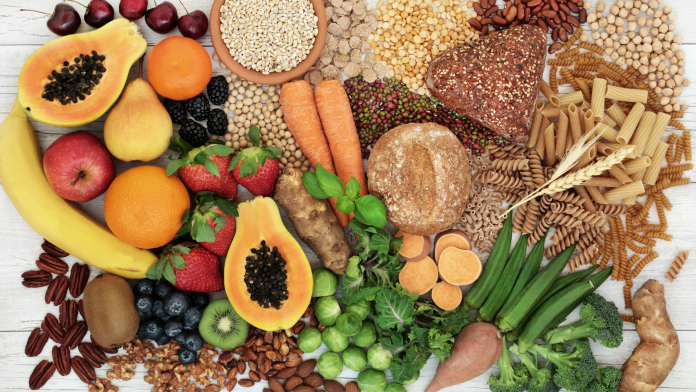Makeover your health? Embrace high-fibre foods. Many people know that dietary fibre helps their digestive system work smoothly. Fibre has many other health benefits! A January 2019 Lancet meta-analysis found that a high-fibre diet reduces the risk of type 2 diabetes and heart disease. High-fibre diets were also linked to decreased colon cancer rates.
According to the Mayo Clinic, fibre consumption is linked to a healthier weight, and a February 2015 Annals of Internal Medicine study found that eating more fibre can help you lose weight.
Another health benefit? “Insoluble fibre adds weight to food and isn’t digested, so it helps enhance feelings of fullness and frequency of bowel movements,” explains Lubbock, Texas-based Lively Table founder Kaleigh McMordie, RDN. The Mayo Clinic says insoluble and soluble kinds have several benefits. McMordie says soluble fibre delays digestion and glucose absorption, helping manage blood sugar. “Soluble fibre absorbs water in the intestines, thickening up stools and preventing diarrhoea.” Insoluble fibre prevents constipation.
Fibre has numerous benefits. According to McMordie, a diet heavy in soluble fibre—found in oatmeal, almonds, and pulses—may lower breast cancer risk. Pulses—lentils, chickpeas, and beans—are legumes, according to North Dakota State University. In April 2020, Cancer released a review and meta-analysis of 20 research that found that people who eat the highest fibre had an 8% decreased risk of breast cancer. Here are the list of 10 High Fibre foods:
1. Green Peas
Green peas are a great source of fibre, with one cup of cooked green peas providing 8 grams of fibre. They’re also an excellent source of protein and contain numerous vitamins and minerals. Green peas are incredibly versatile and can be added to salads, soups, stews, and stir-fries.
2. Artichokes
Artichokes are an excellent source of fibre, with one medium artichoke providing 7 grams of fibre. Artichokes are also a good source of vitamin C, potassium, and magnesium. Artichokes can be cooked in a variety of ways, including steaming, boiling, baking, and grilling.
3. Avocados
Avocados are an excellent source of fibre, with one medium avocado providing 11 grams of fibre. Avocados are also a good source of vitamins C, K, E, and B6, as well as potassium and magnesium. Avocados can be added to salads, sandwiches, wraps, or simply enjoyed on their own.
4. Edamame
Edamame is a great source of fibre, with one cup of cooked edamame providing 8 grams of fibre. Edamame is also a good source of protein and contains numerous vitamins and minerals. Edamame can be eaten as a snack, added to salads and stir-fries, or used as an ingredient in dips and spreads.
5. Beans
Beans are an excellent source of fibre, with one cup of cooked beans providing up to 15 grams of fibre. Beans are also a good source of protein and contain numerous vitamins and minerals. Beans can be used in a variety of dishes, including soups, stews, salads, and dips.
6. Pears
Pears are a great source of fibre, with one medium pear providing 6 grams of fibre. Pears are also a good source of vitamin C and potassium. Pears can be eaten on their own, added to salads and desserts, or used as an ingredient in jams and preserves.
7. Lentils
Lentils are an excellent source of fibre, with one cup of cooked lentils providing 15 grams of fibre. Lentils are also a good source of protein and contain numerous vitamins and minerals. Lentils can be used in a variety of dishes, including soups, stews, salads, and curries.
8. Chia
Chia seeds are a great source of fibre, with two tablespoons of chia seeds providing 10 grams of fibre. Chia seeds are also a good source of protein and omega-3 fatty acids. Chia seeds can be added to smoothies, oatmeal, yogurt, salads, and baked goods.
9. Raspberries
Raspberries are an excellent source of fibre, with one cup of raspberries providing 8 grams of fibre. Raspberries are also a good source of vitamin C and manganese. Raspberries can be eaten on their own, added to smoothies and yogurt, or used as an ingredient in jams and preserves.
10. Wheat Bran
Wheat bran is an excellent source of fibre, with one cup of wheat bran providing 24 grams of fibre. Wheat bran is also a good source of protein and contains numerous vitamins and minerals. Wheat bran can be added to smoothies, oatmeal, yogurt, and baked goods.
Eating a diet rich in fibre is essential for good health and well-being. The above 10 high fibre foods are a great way to get more fibre in your diet. All of these foods are packed with vitamins, minerals, and other nutrients, making them a great choice for a healthy, balanced diet. So, if you’re looking to add more fibre to your diet, try adding some of these foods to your meals and snacks.





